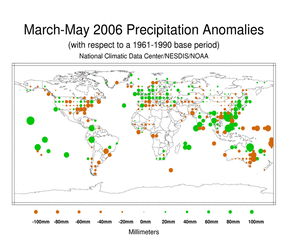Global Highlights:
|
Contents of this Section: |
| The data presented in this report are preliminary. Ranks and anomalies may change as more complete data are received and processed. The most current data may be accessed via the Global Surface Temperature Anomalies page. |
|
The mean position of upper level ridges of high pressure and troughs of low pressure (depicted by positive and negative 500-millibar height anomalies on the March - May 2006 map and the May 2006 map) are generally reflected by areas of positive and negative temperature anomalies at the surface, respectively. |
 larger image |
 larger image |
 larger image |
 larger image |
Temperatures were cooler than average across large parts of the Southern Hemisphere land areas during May 2006. Cooler than average conditions are also reflected in the Mar-May (austral fall) season. Slightly cooler than average temperatures were also present in Russia and Eastern Europe.
Conversely, during Mar-May in the Northern Hemisphere (boreal spring), temperatures were more than 3°C (5°F) above average throughout large parts of Canada, the southern U.S. and northern Mexico, western Africa, and parts of southern Asia. The warmer than average temperatures contributed to persistent or worsening drought conditions in some of these areas. For additional information on drought and other extreme climate conditions refer to the Global Hazards page.
Ocean surface temperatures were warmer than average throughout much of the world during May and Mar-May. Although cooler than average conditions were present in the Niño 1+2 region in the March-May season, warmer than average temperatures throughout the central and eastern equatorial Pacific by May marked the completion of the transition from La Niña to ENSO-neutral conditions. Please see the latest ENSO discussion for additional information.
As shown in the maps
below, large positive temperature anomalies occurred throughout
much of the North American continent during the year-to-date
five-month period. Mean temperatures in excess of 4°C (7°F)
were commonplace, and new monthly mean temperature records were
established in the United States for January and
April.
Above average temperatures were also present throughout much of
South America, Africa, southern Asia and Greenland. Cooler than
average temperatures occurred in eastern Europe, Russia, and
western Australia.
While warmer than average temperatures covered most ocean surfaces during January-May 2006, the presence of cooler than average temperatures in the Niño 3.4 region is evidence of the weak La Niña episode which ended by March Please see the latest ENSO discussion for additional information on the state of conditions in the equatorial Pacific. |
Images of sea surface temperature conditions are available for all weeks during 2006 at the weekly SST page. |
For other Global products see the Climate Monitoring Global Products page. |
|
| Effective with the January 2006 report, NCDC transitioned from the use of the Operational Global Surface Temperature Index (Quayle et al. 1999) to the blended land and ocean dataset developed by Smith and Reynolds (2005). The differences between the two methods are discussed in Smith et al. 2005. |
| Current Month / Seasonal / Year-to-date |
| May | Anomaly | Rank | Warmest Year on Record |
|---|---|---|---|
GlobalLandOcean Land and Ocean |
+0.59°C (+1.06°F) +0.47°C (+0.85°F) +0.50°C (+0.90°F) |
7th warmest 3rd warmest 5th warmest |
2000 (+1.31°C/2.36°F) 1998 (+0.53°C/0.95°F) 1998 (+0.70°C/1.26°F) |
Northern HemisphereLandOcean Land and Ocean |
+0.95°C (+1.71°F) +0.46°C (+0.83°F) +0.64°C (+1.15°F) |
4th warmest 3rd warmest 3rd warmest |
2000 (+1.66°C/2.99°F) 2004 (+0.53°C/0.95°F) 2005 (+0.83°C/1.49°F) |
Southern HemisphereLandOcean Land and Ocean |
-0.45°C (-0.81°F) +0.48°C (+0.86°F) +0.34°C (+0.61°F) |
25th coolest 2nd warmest 11th warmest |
1992 (+1.41°C/2.54°F) 1998 (+0.59°C/1.06°F) 1998 (+0.63°C/1.13°F) |
 larger image |
 larger image |
| March-May | Anomaly | Rank | Warmest Year on Record |
|---|---|---|---|
GlobalLandOcean Land and Ocean |
+0.74°C (+1.33°F) +0.42°C (+0.76°F) +0.51°C (+0.92°F) |
8th warmest 6th warmest 6th warmest |
2002 (+1.16°C/2.09°F) 1998 (+0.44°C/0.79°F) 2004 (+0.56°C/1.01°F) |
Northern HemisphereLandOcean Land and Ocean |
+0.97°C (+1.75°F) +0.40°C (+0.72°F) +0.61°C (+1.10°F) |
5th warmest 6th warmest 6th warmest |
2002 (+1.53°C/2.75°F) 1998 (+0.49°C/0.88°F) 2002 (+0.78°C/1.40°F) |
Southern HemisphereLandOcean Land and Ocean |
+0.08°C (+0.14°F) +0.45°C (+0.81°F) +0.40°C (+0.72°F) |
49th warmest 5th warmest 8th warmest |
1998 (+0.73°C/1.31°F) 1998 (+0.41°C/0.74°F) 1998 (+0.45°C/0.81°F) |
 larger image |
 larger image |
| January-May | Anomaly | Rank | Warmest Year on Record |
|---|---|---|---|
GlobalLandOcean Land and Ocean |
+0.69°C (+1.24°F) +0.40°C (+0.72°F) +0.48°C (+0.86°F) |
11th warmest 6th warmest 6th warmest |
2002 (+1.29°C/2.32°F) 1998 (+0.53°C/0.95°F) 2002 (+0.66°C/1.19°F) |
Northern HemisphereLandOcean Land and Ocean |
+0.82°C (+1.48°F) +0.36°C (+0.65°F) +0.53°C (+0.95°F) |
11th warmest 6th warmest 7th warmest |
2002 (+1.54°C/2.77°F) 2004 (+0.50°C/0.90°F) 2002 (+0.83°C/1.49°F) |
Southern HemisphereLandOcean Land and Ocean |
+0.32°C (+0.58°F) +0.44°C (+0.79°F) +0.43°C (+0.77°F) |
18th warmest 6th warmest 7th warmest |
2005 (+0.89°C/1.60°F) 1998 (+0.56°C/1.01°F) 1998 (+0.61°C/1.10°F) |
 larger image |
 larger image |
The most current data may be accessed via the Global Surface Temperature Anomalies page.
The maps below represent anomaly values based on the GHCN data set
of land surface stations using a base period of 1961-1990. During
March-May 2006, above average precipitation fell over areas that
include India, Brazil, northern Australia, the Philippines, and
Hawaii. Below average precipitation was observed in southern
Brazil, Argentina, Pakistan, eastern Australia, and the
southeastern U.S. Additional details on drought and heavy
precipitation can also be found on the May Hazards page. |
 larger image |
 larger image |
|
|
|
 NOAA's National Centers for Environmental Information
NOAA's National Centers for Environmental Information



